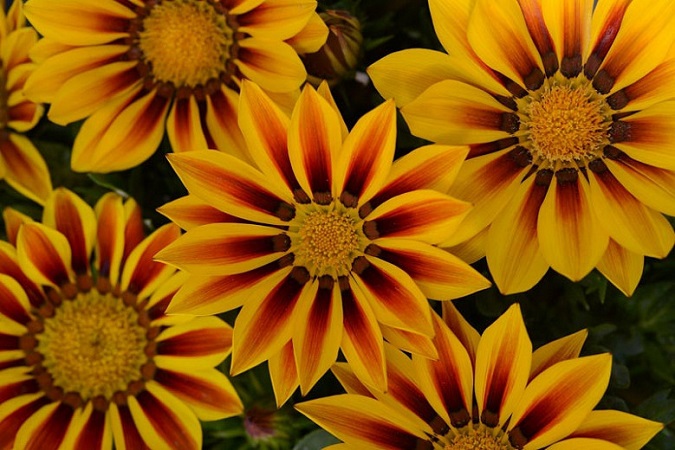If you’re looking for a showy annual bloom in the sunny garden or the container, and something that is almost care free, try growing gazanias. In USDA hardiness zones 9 through 11, Gazanias perform as herbaceous, tender perennials.

Gazania is a genus of about 20 species in the family Asteraceae, native to southern Africa. Gardeners love them for their large, unique patterned, daisy-like flowers in a wide variety of colors. The blooms, as with all the members of the daisy family, are flower heads composed of disk florets at the center. These plants are considered annuals in the cool climates, but in warmer climates they are short-lived perennials. They are vibrant, drought tolerant and easy to maintain. It is always such a delight when they pop into bloom.
Plant Care
Care of Gazania flowers is limited and often non-existent if you have neither the time nor the inclination to care for them. Botanically called Gazania rigens, treasure flowers is a more common name. The plant is often referred to as the African daisy (though not to be confused with Osteospermum African daisies). The South African native often trails along the ground. In areas where it is hardy, landscapers use this plant in combination with other low growers as an ornamental ground cover to edge lawns or even replace parts of them.
Gazanias will reach 6 to 18 inches in height and about the same in spread as it trails on the ground. A clumping mound of grass-like foliage produces Gazania treasure flowers. This easy-to-grow bloom is tolerant of poor, dry, or sandy soil. Heat and salty spray don’t deter its growth or beautiful blossoms either, making it a perfect specimen for oceanfront growing.
Gazanias bloom in vivid shades of red, yellow, orange, pink, and white and can be two tone or multi-colored. Showy blooms appear in early summer through early fall on this annual wildflower. Care is simple once they’re planted and established in the garden, as it does not involve much of anything, other than watering. Although they’re drought resistant, expect more and bigger blooms when you water. Even drought resistant flowers benefit from water, but the Gazania takes droughty conditions better than most. You can begin growing Gazanias by planting seeds directly into the ground or container when all chances of frost are past. Start seeds indoors earlier for the earliest blooms of Gazania treasure flowers. Deadhead spent blooms.
Propagation
Cuttings can be taken in fall and overwintered indoors, away from freezing temperatures. The plant from which the cuttings are taken will benefit from this and you can get more plants started. Take several cuttings if you plan to use them in a large area as groundcover. Get the cuttings started in 4-inch pots, in a good quality potting soil. Plant rooted cuttings in spring at 24 to 30 inches apart. Keep watered until plants are established, then water every two weeks throughout summer. Overhead irrigation is acceptable when watering Gazanias.
Fun Facts About Gazanias
Name Meaning
The genus was named after the Greek humanist Theodorus Gaza, who was an influential Greek scholar of the 15th century.
Gazania Symbolism
Gazania represents wealth and richness.
Gazanias Sleep at Night
Gazania flowers are light-sensitive. They close at night and on particularly cloudy days. It is a behavior called nyctinasty. Although the reason for this behavior isn’t fully understood, some scientists believe that this behavior prevents pollen from becoming wet and heavy with dew. Charles Darwin, well known for his theory of evolution, thought that plants close at night to protect themselves from freezing. Closing at night may also protect the pollen from unwanted pests. These plants aren’t sleepy, they are just highly evolved.
Is Gazania Poisonous?
The plant is not considered toxic, but if eaten, it may cause discomfort. Since pets frequently chew on new plants introduced to the home, it is recommended to keep it out of the reach of your pets.
Is Gazania Invasive?
Gazania can become invasive in some areas. Some varieties, such as Gazania rigens and Gazania linearis, are considered very invasive in some countries. Gazania Linearis is classified as invasive in California.
Benefits and Uses of Gazania
This plant is sometimes used in folk medicine to treat pneumonia, sore eyes, headache, earache, and sterility.
Related Articles & Free Email Newsletter Sign Up
How to Properly Divide Daylilies
Hydrangeas! When Do I Prune Them and Why Didn’t They Flower?
Peppermint Twist Offers Stunning Color and Disease Resistance




Comment here